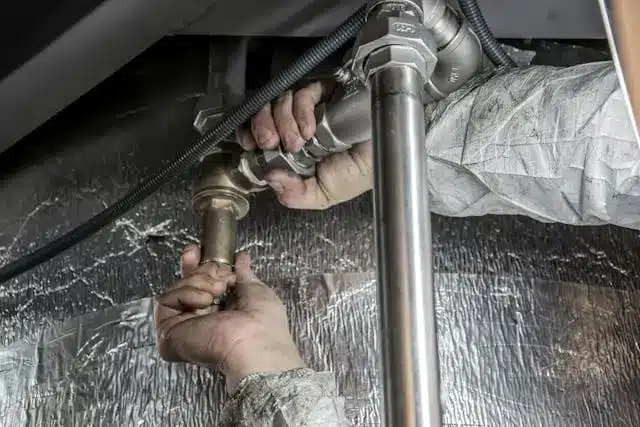Choosing the right size boiler for your home or business is essential for both comfort and cost efficiency. A properly sized boiler keeps your space warm without wasting energy, helping to reduce your utility bills.
Conversely, an oversized or undersized unit can lead to wasted energy, increased costs, and faster system wear. Whether you are upgrading an existing system or installing a new one, getting the sizing right is vital to avoid unnecessary expense and inconvenience.
This guide explains how to determine the correct boiler size for your needs.
Understanding Boiler Sizing Basics
Boiler sizing refers to the process of determining the right boiler capacity for your home or business. In simple terms, it involves choosing a boiler that can heat your space efficiently without wasting energy or incurring extra costs. A boiler that is too small will struggle to provide enough heat, while one that is too large will consume more energy than necessary and increase your bills.
Several factors affect boiler sizing. The most important is the heat load, which measures how much heat your building requires. This depends on the size of the property, insulation levels, window types, and local climate conditions. The type of heating system also matters, as underfloor heating systems may require a different boiler capacity than radiator-based systems.
There are several types of boilers to consider. For residential settings, the three most common are combi boilers, system boilers, and heat-only boilers. Each suits specific property types and heating requirements. In commercial environments, systems such as fire-tube, water-tube, electric, and condensing boilers are more common, as they can handle larger spaces and higher heating demands.
To find the right fit, it helps to understand both your heating requirements and the boiler parts that make up the system. A properly sized boiler ensures efficient performance and long-term reliability.
Steps for Sizing a Residential Boiler
Sizing a residential boiler starts with calculating the heating load, which represents the amount of heat your home requires to stay comfortable. Begin by measuring your home’s total floor area and consider factors such as insulation, window quality, and climate. Heating load calculations, including the Manual J method, provide a precise estimate.
Next, take domestic hot water demand into account. Consider how much water your household uses for showers, dishwashing, and laundry. Think about how many people live in your home and whether multiple water outlets are used simultaneously, as this affects overall demand.
The type of heating system you have will also influence boiler size. Radiators, underfloor heating, and forced-air systems each have different efficiency levels and output requirements. Use general rules of thumb to estimate boiler capacity in BTUs, then adjust based on the specific characteristics of your property.
By assessing each of these factors, you can select a boiler that provides consistent warmth and efficient operation.
Common Sizing Mistakes to Avoid
When sizing a boiler, it’s easy to make mistakes that could cost you money or leave your space uncomfortable. One common mistake is oversizing the boiler. A unit that’s too big can lead to short cycling, where the boiler constantly turns on and off, wasting energy and increasing your bills.
On the other hand, undersizing the boiler can result in inadequate heating, especially during cold weather. The system will have to work harder, leading to unnecessary strain and potential breakdowns.
Another mistake is ignoring long-term changes in your home or business, like an increase in occupancy or expansion. These factors can alter your heating needs over time, so it’s essential to consider them.
Lastly, don’t forget about seasonal variations. The size of your boiler should be determined by the local climate and the annual temperature fluctuations. Ensure it’s capable of handling the colder months when heating demand is at its peak.
These simple mistakes can lead to energy inefficiency and higher costs if not carefully considered.
Boiler Sizing Tools and Software
When sizing a boiler, several methods should be taken into consideration. Manual load calculations involve measuring the heating load manually using formulas such as the Manual J method for residential spaces. This gives a precise figure based on your home’s square footage, insulation, and climate. For larger commercial projects, tools like HTR and other software programs help calculate the required boiler size more easily.
If you’re looking for a quicker way, online sizing calculators can be a great help. Manufacturers often offer these tools on their websites. Simply input details such as your home’s square footage, insulation, and system type, and the calculator will provide an estimate of the boiler size you need.
Lastly, when in doubt, it’s always a good idea to consult an HVAC expert or heating engineer. They can ensure you get the perfect fit and avoid costly sizing errors that could impact your system’s performance.
Get the Right Size, Maximise Efficiency
Choosing the correct boiler size is crucial for maintaining comfort, efficiency, and cost control in both residential and commercial properties. By carefully assessing heating load, hot water demand, and system type, you can ensure your boiler operates efficiently without wasting energy. Avoiding common sizing errors and following a consistent maintenance plan will keep your system running smoothly for many years.
Whether you rely on a professional or use sizing tools as a starting point, making an informed decision at the outset helps you achieve maximum efficiency and long-term savings.
